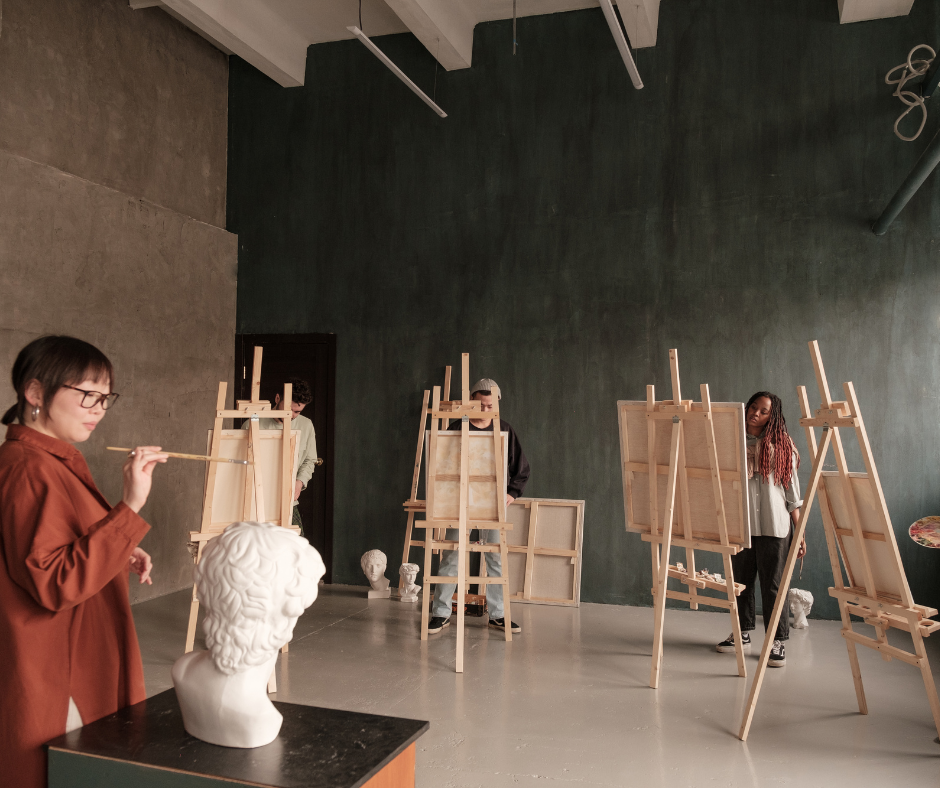

As a Creative, Do You Have an Autotelic Personality?
Summary
Reflection Questions
Journal Prompt
The term ‘autotelic’, derived from the Greek words for ‘self’ (auto) and ‘goal’ (telos), refers to activities or behaviors that are pursued for their own sake, driven by intrinsic rewards rather than external incentives. Central to this concept is the notion of finding inherent satisfaction and fulfillment in the activity itself. In this article, we will explore the defining features and the psychological underpinnings that characterize autotelic activities and autotelic personalities. We will pay particular attention to the prevalence of autotelic traits among creative individuals, examining why those engaged in creative pursuits often exhibit a strong inclination towards such self-rewarding experiences. Are you an autotelic person? Read on to learn more about autotelic personality traits and how they present in everyday life.
Understanding Autotelic Activities


Autotelic activities are actions or pursuits engaged in for their intrinsic value, where the primary reward lies in the experience itself rather than external outcomes or accolades. These activities are self-contained, with their goals and purposes residing within the actions, making the process of undertaking the activity its own reward.
Characteristics of Autotelic Activities
The key characteristic of autotelic activities is their focus on intrinsic motivation. Individuals engaged in these activities do so for the sheer pleasure, satisfaction, or challenge they present, rather than for external rewards such as money, fame, or approval. This intrinsic motivation often leads to a state of ‘flow’, a deeply immersive and enjoyable experience where individuals lose track of time and are fully absorbed in the activity at hand.
Examples of Autotelic Activities in Various Domains
Examples of autotelic activities can be found across a wide range of domains. In the arts, activities like painting, writing, or playing a musical instrument are often pursued for personal satisfaction and expression.
In sports, activities like rock climbing or marathon running, where personal challenge and achievement are central, exemplify autotelic pursuits. Even in everyday life, activities such as gardening, cooking for pleasure, or engaging in a hobby like knitting or woodworking can be autotelic, offering personal fulfillment and joy independent of any external validation.
Exploring Autotelic Personalities


An autotelic personality is characterized by a tendency to engage in activities for the sake of the experience itself, driven by intrinsic motivation and satisfaction. Individuals with this personality type find joy and fulfillment in the process of an activity, regardless of external rewards or recognition. They are typically self-directed, curious, and often exhibit a persistent dedication to their interests and passions. Their satisfaction comes from the activity itself rather than the end result.
Psychological Basis of Autotelic Personalities
The psychological basis of autotelic personalities sets them apart from other personality types that may rely more on extrinsic motivations. Autotelic individuals possess a natural inclination to seek challenges and experiences that promote personal growth and fulfillment.
This intrinsic motivation is often accompanied by high levels of creativity, resilience, and an ability to find meaning and enjoyment in a variety of situations. They are also known for their ability to remain engaged and composed under pressure, turning potential stressors into enjoyable challenges.
The Concept of ‘Flow’ and ‘Flow State’ in Relation to Autotelic Personalities


The concept of ‘flow,’ introduced by psychologist Mihaly Csikszentmihalyi, is closely related to autotelic personalities. Flow state is a mental state in which a person is fully immersed in an activity, experiencing a feeling of energized focus, full involvement, and enjoyment.
It is a state of intense concentration. Regarding flow, Csikszentmihalyi suggests that any number of factors influence performance results and eventually lead to the completion of a task, but a creative personality is more likely to experience flow because of intrinsic motivation. He posits that an intense challenge undertaken by a person who is highly skilled in that arena is likely to trigger the flow state because that person is engaged but not stressed.
Autotelic personalities are more predisposed to experiencing flow, as they engage deeply in tasks that resonate with their intrinsic interests. In a flow state, time seems to pass by unnoticed, and the individual is absorbed in the activity to the extent that external distractions are tuned out, often leading to high levels of productivity and creativity. Let’s take a closer look at flow experiences.
Flow Proneness
Flow proneness refers to an individual’s tendency or predisposition to experience flow states frequently in their daily lives. People with high flow proneness easily become absorbed in their activities, finding deep engagement and losing track of time often.
This is typically a trait of individuals who are intrinsically motivated and seek out challenges that match their skills, leading to regular occurrences of flow. Such individuals usually have hobbies or professions that enable them to engage in tasks that are both enjoyable and challenging, facilitating frequent entry into flow states.
Experiencing Flow State
Flow experience, on the other hand, describes the state itself – a specific mental state of immersion and absorption in an activity Characteristics of flow experience include a sense of effortlessness, a loss of self-consciousness, a distorted sense of time (often feeling like time is flying), and a feeling of being in control of the situation or activity.
Achieving flow is only possible when there is a balance between the challenge of the task and the skill level of the individual. If the task is too easy or too difficult relative to the person’s skill, flow is less likely to occur. During flow, people often experience a deep focus, a merging of action and awareness, and a sense of intrinsic reward from the activity itself.
Autotelic Personalities and Creativity
Why Creative Individuals Are Often Autotelic


Creative individuals frequently exhibit autotelic personalities due to the intrinsic nature of the creative process. Creativity often involves exploring new ideas, self-expression, and personal satisfaction, which aligns closely with autotelic traits.
For creatives, the act of creating – whether it’s art, music, writing, or any other form – is rewarding in itself. They engage in creative activities not necessarily for external rewards but for the personal joy and fulfillment that the creative process brings. This intrinsic drive fosters a deep engagement in their work, leading to frequent experiences of flow and sustained creative output.


are you a fine artist or photographer?
Relationship Between Creativity, Flow, and Intrinsic Motivation
The relationship between creativity, flow, and intrinsic motivation is deeply interlinked. Creativity flourishes in an environment where there is freedom to explore and express without external pressures. Flow, a state of complete absorption in an activity, is more easily achieved in tasks that align with one’s intrinsic interests, a common scenario in creative endeavors.
This state of flow can enhance creativity, as it allows for focused attention, reduced self-consciousness, and the merging of action and awareness – all conducive to creative thinking. Intrinsic motivation, meanwhile, drives individuals to persist in their creative pursuits, even in the absence of external validation or reward.
Creative Individuals Who Likely Had Autotelic Personalities


Numerous well-known creative individuals exemplify autotelic personalities. For instance, painter Vincent van Gogh pursued art for its own sake, often without regard for commercial success or recognition. His deep intrinsic motivation and commitment to his artistic vision are evident in his prolific work, despite the lack of acclaim during his lifetime.
Another example is the famous writer Virginia Woolf, who was known for her immersive and innovative approach to writing, driven by a deep passion for storytelling and literary exploration. These cases highlight how the autotelic nature of these individuals fueled their remarkable creativity and enduring legacies in their respective fields.
Benefits of Autotelic Activities and Personalities
Psychological and Emotional Benefits of Engaging in Autotelic Activities
Engaging in autotelic activities offers substantial psychological and emotional benefits. These activities, being intrinsically rewarding, contribute to a person’s overall well-being and mental health. They often lead to experiences of flow, which are associated with reduced stress, increased happiness, and a sense of accomplishment.
By focusing deeply on the task at hand, individuals experience a break from daily worries and anxieties, leading to improved emotional regulation and resilience. Additionally, autotelic activities encourage creativity and problem-solving skills, contributing to cognitive flexibility and mental agility. They rarely seek fame or power and desire few material possessions because of their intense intrinsic motivation. Autotelic personalities are rarely motivated by future benefit, enjoying small moments in their normal everyday life instead.
Higher Levels of Personal Satisfaction and Fulfillment in Autotelic Personalities


Individuals with autotelic personalities typically experience higher levels of personal satisfaction and fulfillment. Since their motivation comes from within, they are less reliant on external validation or rewards for their sense of self-worth and happiness.
This intrinsic motivation drives them to pursue goals and activities that are personally meaningful and enjoyable, leading to a more fulfilling life. Autotelic individuals are also more likely to experience flow regularly, which enhances their engagement with life and contributes to a deep sense of satisfaction. Their ability to find joy and interest in a variety of experiences enables them to maintain a positive outlook and a high level of personal contentment.
Challenges and Misconceptions
Autotelic individuals often face challenges in environments heavily driven by extrinsic rewards. In such settings, their intrinsic motivation and focus on the activity itself rather than the outcome can be at odds with external expectations and reward structures.
They might struggle with environments that prioritize tangible achievements over the process, potentially leading to a mismatch between their personal values and external demands. Additionally, their deep engagement in activities can sometimes lead to overlooking practical aspects like time management or balancing various life responsibilities.
A common misconception about autotelic activities is that they are always leisurely or non-productive. In reality, the activities that those with an autotelic personality undertake can be highly engaging, demanding, and contribute significantly to personal growth and skill development.
Another misconception is that autotelic personalities are less ambitious or driven. In contrast, autotelic individuals often exhibit high levels of dedication and perseverance in their pursuits; their drive is simply oriented more towards internal satisfaction than external rewards. Furthermore, it’s often misunderstood that autotelic traits are limited to artistic or creative fields, whereas they can be found in any domain where individuals engage deeply with their work or hobbies.
Fostering Autotelicity


Cultivating autotelic experiences can enhance your enjoyment and engagement in various aspects of life. Below are some tips to foster these experiences.
Identify Intrinsically Motivating Activities: Reflect on activities that you enjoy purely for the experience, not for external rewards or recognition.
Set Personal Goals: Align your goals with your interests and passions rather than external expectations or pressures.
Engage in Mindful Practices: Practice mindfulness to stay present and fully engaged in your current activity, enhancing the potential for deep involvement and flow.
Seek Challenges that Match Your Skills: Choose tasks that are neither too easy nor too hard, but that perfectly balance your skill level with the challenge they present.
Cultivate Curiosity: Foster a sense of curiosity and openness to new experiences, encouraging exploration and learning.
Balance Structure and Flexibility: Have a flexible approach to your tasks and hobbies, allowing for spontaneous engagement in enjoyable activities.
Embrace Failure as a Learning Opportunity: View setbacks and failures as chances to learn and grow, rather than as deterrents.
Allocate Time for Personal Interests: Regularly set aside time for activities that you find fulfilling and enjoyable.
Practice Autonomy in Tasks: Whenever possible, make your own choices about how to approach a task, fostering a sense of control and personal investment.
Reduce External Distractions: Create an environment conducive to focus and immersion, minimizing interruptions and distractions.
Reflect on Your Experiences: Take time to reflect on what activities bring you the most joy and satisfaction, and why.
Share Your Experiences with Others: Engage with communities or groups that share your interests, which can heighten your enjoyment and commitment to the activity.
Learn to Recognize the State of Flow: Become aware of when you’re in a flow state, and note what contributed to entering this state, so you can recreate those conditions in the future.
Prioritize Personal Growth: Focus on activities that contribute to your personal development and sense of self-improvement.
Experiment and Explore: Don’t hesitate to try new things and step out of your comfort zone, as this can lead to discovering new autotelic activities.
By integrating these strategies into one’s daily life, one can increase the frequency and quality of autotelic experiences, leading to greater personal fulfillment and well-being.
Encouraging Autotelic Traits in Society
Society can play a significant role in nurturing autotelic traits by valuing intrinsic motivation and personal fulfillment as much as external achievements. This can be fostered through community programs and workshops that emphasize skill development and personal growth over competition and rewards.
Workplaces can encourage autotelicity by allowing for autonomy, providing tasks that match employees’ skills and interests, and recognizing efforts and processes, not just outcomes. Media and cultural narratives celebrating intrinsic rewards and self-driven achievements can also shift societal attitudes towards appreciating autotelic pursuits.
Nurturing Autotelic Traits in Educational Systems
Educational systems can nurture autotelic traits in children by creating learning environments that encourage exploration, curiosity, and intrinsic motivation. This involves offering a variety of activities that cater to different interests and allowing students some choice and autonomy in their learning process.
Educators should emphasize the joy of learning and the process of discovery over grades and test scores. Encouraging project-based learning, where students engage in projects they are passionate about, can also cultivate autotelicity. Additionally, teaching children about the concept of flow and how to achieve it can equip them with the ability to engage deeply in activities and find personal satisfaction in their pursuits.
Final Thoughts on Autotelic Traits


Autotelic activities, characterized by their inherent reward and enjoyment, offer significant psychological and emotional benefits, leading to heightened experiences of flow and deep engagement. Individuals with autotelic personalities, often found within creative fields, exemplify the value of pursuits driven by passion and personal satisfaction, rather than external rewards.
Understanding and embracing autotelicity not only enriches personal experiences but also fosters a deeper connection to one’s work and hobbies. Especially in creative endeavors, where innovation and expression are paramount, cultivating an autotelic approach can lead to more meaningful, fulfilling, and inspired creations.








